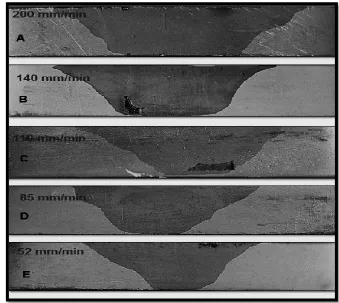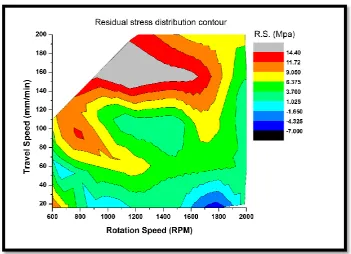Effect of process parameters on residual stress in AA1050 friction
stir welds
Ahmad W. Shafey
1, Essam Bahgat
2, MoustafaHamed
3, Ahmed Khayri
4 1M.Sc. student of Mechanical Engineering Department, Faculty of Engineering KAU.
2, 3
Mechanical Engineering Department, Faculty of Engineering, KAU, Saudi Arabia
Abstract:In the current work, aluminum AA1050 plates has been successfully joined using friction stir welding (FSW) technique. The effect of processing parameters such as tool rotation speed and travel speed on the mechanical properties are investigated. Residual stress has been carried out using the destructive cutting length method; the results found that common stresses are compressive type, which are formed due to friction stir welding process. The results revealed that welding travel speed has a remarkable influence on the resultant residual stress.
I. Introduction
Friction stir welding (FSW), which was developed in 1991 by TWI [1]. It is an advanced joining technique used recently in many applications in automotive and aerospace industries. The mechanical properties were improved in the welding stirred zone, due to lower heat generation and fine grains formed during friction stir welding process. FSW having of various zones along the welding direction process, involving different mechanical properties and microstructures. Stirring zone (ST) consider the focus welding point and it has the maximum welding temperature. The heat-affected zone (HAZ) is formed due to effect of thermal cycles on the mechanical properties and consider the most nearest zone from the joint centerline path. Theresearchers [2],[3], [4]and [5]were investigated the relation between residual stress and HAZ they are reported that maximum longitudinal residual stresses are formed in the
HAZ.The last zone formed named as
thermomechanical affected zone (TMAZ), this formed because of dynamic grain recrystallization in the nugget zone or stirring zone. At the two previous zones, (HAZ) and (TMAZ) the residual stresses has been arise in these regions.
Residual stresses are a follow-up of anirregular thermal distribution and plastic deformation of different zone. This can arise due to complex thermomechanical interactions during welding
process. Many researchers [6], [7] , [8] and [9].studied the side effect for existing residual stresses in the welded structure and they reported that Residual stresses should be minimized if the welded structure is subjected to fatigue or corrosion. The effect of process parameters on residual stress profiles in FSW is unlike other welding processes as reported by [10]and [11]. The welded plate thickness cause higher level of residual stress[12]. H. Lombard. et al [13] use Synchrotron X-ray diffraction to measure residual stresses for AA5083-H321 plates the investigators reported that The heat input and welding travel speed have a significant influence on the residual stress. The aim of this paper is to study the effectof the welding parameters on the magnitude of the residual, furthermore the temperature distribution during welding process.
II. Experimental procedure Aluminum sheets (AA 1050 O) are chosen for this study. The product available was in the form of rolled plate of dimensions 200 mm x 60 mm x 6 mm, Ithas found wide range usage electrical and chemical industries. Because of good anelectrical
conductivity, corrosion resistance, and
machinability. It has low mechanical strength compared to more significantly alloyed metals. It can be strengthened by cold working mechanical properties with pre-determined values such as listed in Table 2.1
Table 3- 1 Aluminum alloy 1050 contents.
Alloy Si Fe Cu Mn Mg V others Al
The initial FSP tool material is cold worked tool steel (K110 steel), and the design consists of a simple cylindrical tool shoulder with 25 mm. The probe is slightly shorter than the thickness of the workpiece and its diameter is typically equal to 6 mm. The chemical composition of tool material are presented in tables 3.2. Figure (1)illustrates the tool designfor the tool used in this study and a photograph for the FSW process. In all experiments, the tool-tilting angle was fixedat 2o and the friction pressure was held constant.
Table 2- 2: Chemical composition of tool material
Element C Cr Mo Si Mn V Fe
Wt. (%) 1.5 11 1.1 0.6 0.5 0.5 Bal.
Different rotational speed of the tool used with various welding speed described in the table 2.3. FSW joints were carried out using an automatic milling machine. The welding tool is rotating into clockwise direction and traveled along the specimen, which is tightly fixed at the backing plate. Single-sided welds were applied to the plates. Residual stresses measurement were performed using Sectioning technique , it is consider a destructive method that relies on the measurement of Deformation due to the release of residual stress upon removal of material from the specimen. This technique can be executed using CMM machine for precise and accurate measurement.
Table 2- 3 : FSW Parameters for rotation speeds and welding speeds
Rotation speed - RPM 600 800 1000 1200 1500 1600 1800 2000
Travel speed – mm/min 16 20 32 52 85 110 140 200
3.1 Residual stress
Residual stress resulting from two combined cases first, exceeding the elastic limit due to plastic deformation in presence of a temperature gradient in FSW. Second, Residual stress resulting from a change of metallurgical phase because of the material grain s are changed to finer form. Common residual stresses type, which are produced in the experimental work during FSW at all operating conditions shown in figure (2).
it can be considered that the type of residual stress in the overall processing condition is a compressive stresses. That is mean that increasing fatigue life and minimize the welding cracks.
3.2 Effect of
rotational speed and welding rate
Heat generated during welding process isdepending on the rotational speed and the welding rate, increasing tool rotation speed produces more heat generation between aluminum plate and tool pin with shoulder. The welding rate or travel speed has a very important role in the welded plates properties and quality. Increasing the rotational speed, leads to an increase in size of the nugget zone, the nugget zone became wider and flatter. This is attributed to high heat input and stirring increment in the metal. Therefore, a large amount of frictional and plastic-work heat is produced and because of easy material flow, a bigger nugget is formed as
seen in figure (3).
As mentioned before increasing rotation speed with higher welding rate decreasing the residual stress as shown in figure (4). Higher welding rate lead to minimize the heat generating produced from tool rotation speed during FSW. Residual stress minimized by more than 60% if the ratio of the welding rate to rotation speed lower than 10 %.With decreasing traverse speed and tool rotation rate, the residual stresses decreased this consistent with [14],[13] and [15].
Residual stress distribution contour for welding parameters as shown in figure (5), the lower welding rate with high tool rotation speed obtain the optimum welding condition with minimum residual stress. The contours show that maximum residual stress produced during FSW at low rotation speed with higher travel welding speed.
Figure (4): Effect of rotation speed on residual stress thought different welding speed.
IV. Conclusion
From the previous results, it can be concluded that:
Residual stresses effected by the welding parameter, moreover processing parameters responsible on
the types of resultantstresses.
Friction stir welding (FSW) with a designed welding process parameters at high rotation speed and
lower welding rate give minimum residual stresses with better welding quality.
References
[1] T. WM, "Friction stir butt welding," International Patent Application, vol. 9125978.8., 1991.
[2] D. C. Dalle , E. Lima and Wegener, "Investigations on residual stresses in friction stir welds.,"
TWI (ed), Proc 3rd int symp FSW, Kobe, Japan, 2001.
[3] P. M, A., . P. M and W. P.J. , "Microstructure, mechanical properties and residual stresses as a function of welding speed in aluminium AA5083 friction stir welds," Acta Materialia, p. 4791– 4801, 2003.
stir welds in aerospace alloys," International Journal of Fatigue, vol. 25, p. 939–948, 2003.
[5] . W. W., F. Z. , W. X.L. and . B. D. W., "In situ neutron diffraction measurements of temperature and stresses during friction stir welding of 6061-T6 aluminium alloy," Science and Technology of Welding and Joining, vol. 12, pp. 298-303, 2013.
[6] T. Inoue and Z. Wang, "Coupling between stress, temperature, and metallic structures during processes involving phase transformations," Mater. Sci. Technology, vol. 1, p. 845–850, 1985.
[7] Y. Itoh and . S. Suruga, "Prediction of fatigue crack growth rate in welding residual stress fields,"
Eng. Fract. Mech, vol. 33, pp. 397-407, 1989.
[8] G. Bussu and I. , "The role of residual stress and heat affected zone properties on fatigue crack propagation in friction stir welded 2024-T351 aluminium joints," Int. J. Fat, vol. 25, pp. 77-88, 2003.
[9] . M. T. Milan and Bowen, "Fracture toughness of selectively reinforced aluminium alloys: pre-crack tip in the composite side," Metall. Mater. Trans., vol. 35, pp. 1393-1401, 2004.
[10] S. P. and W. , "Dissimilar friction stir welds in AA5083-AA6082. The effect of process parameters on residual stress," Materials Science and Engineering A, vol. 441, p. 187–196., 2006.
[11] P. . M. J, S. A. and . W. , "Dissimilar friction stir welds in AA5083-AA6082. Part II: Process parameter effects on microstructure," Metallurgical And Materials Transactions A-Physical Metallurgy and Materials Science, vol. 37, p. 195–220., 2006.
[12] P. Staron and K. M , "Residual stresses in friction stir welded Al sheets," Applied Physics A Materials Science & Processing , vol. 1162, p. 1161, 2002.
[13] L. H., . H. D.G. and S. A. , "Effect of process parameters on the residual stresses in AA5083-H321 friction stir welds," Materials Science and Engineering A, vol. 501, p. 119–124, 2009.
[14] D. C.D. , E. Lima and W. J. , "Proceedings of the Third International Symposium on Friction Stir Welding," in Friction Stir Welding, Kobe, Japan, 2001.




